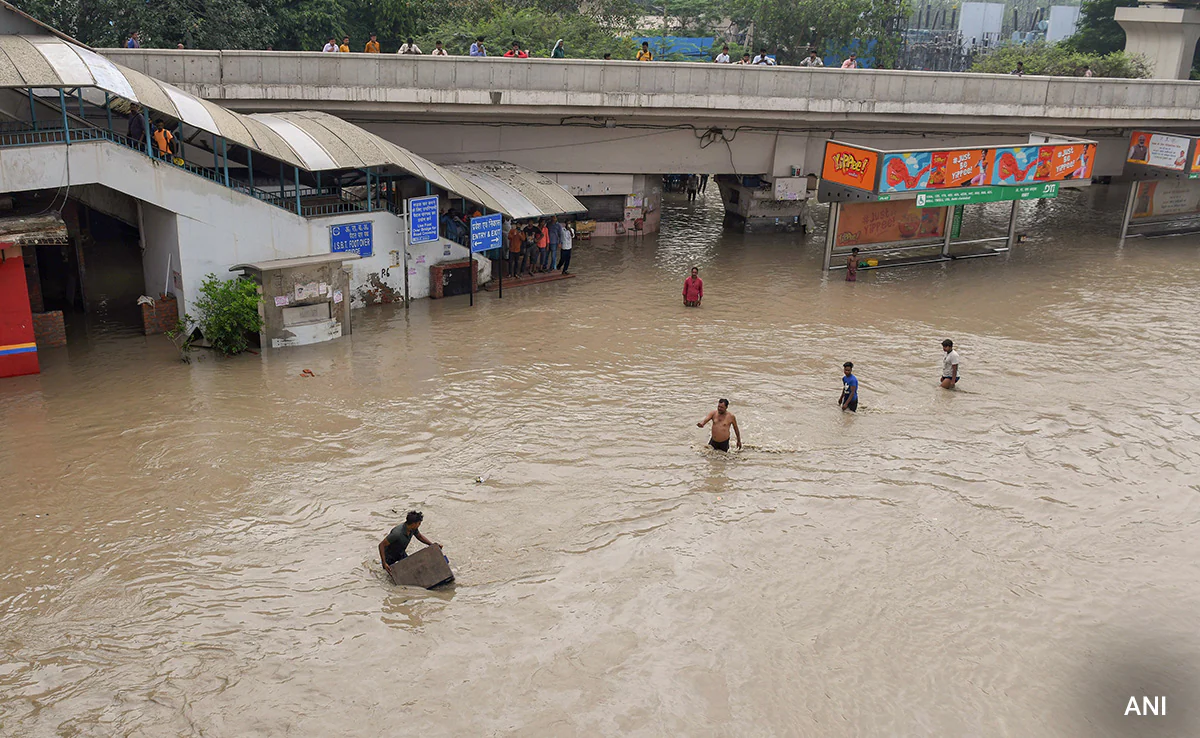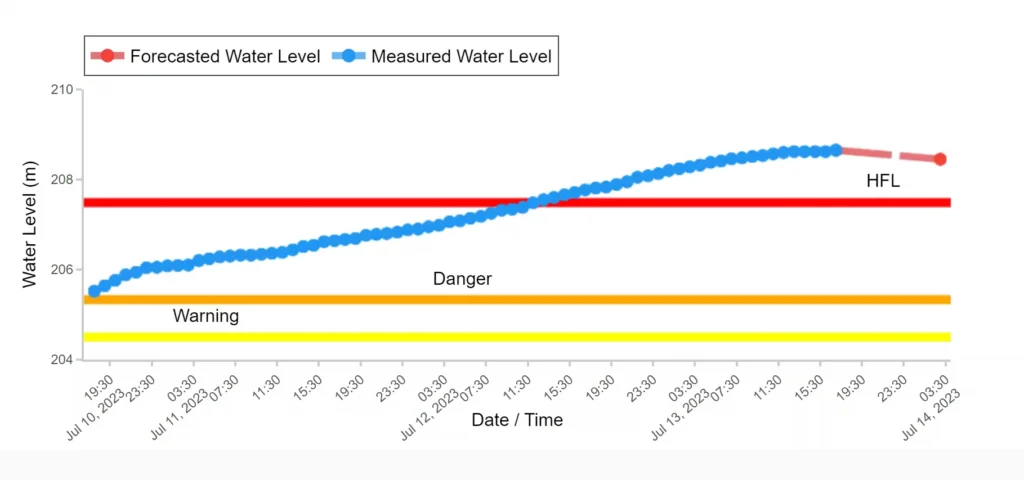Online Yamuna Water Level Check: Essential Steps for Monitoring Delhi’s Extreme Flood Situation

Delhi Flood Crisis: Battling Record-breaking Yamuna River Levels
Delhi is currently grappling with an extreme flood crisis as the water levels of the Yamuna River soar to unprecedented heights. In this blog, we provide essential information on how to monitor the Yamuna water levels online. Stay informed and make informed decisions amidst the challenging flood situation by following our step-by-step guide.
Discover the official sources and websites to access real-time updates, historical data, and graphs related to the water levels. With this knowledge at your fingertips, you can prioritize your safety, stay ahead of the flood situation, and navigate the crisis with caution. Stay connected and informed during Delhi’s flood crisis.
Delhi’s recent battle with flooding has wreaked havoc in numerous parts of the city, particularly the Yamuna floodplains, as well as low-lying areas such as Civil Lines and Kashmere Gate.
The cause behind this catastrophic situation is the significant rise in the water levels of the Yamuna River.
Currently, the water level at the Old Delhi Railway Bridge stands at a staggering 208.65 meters, surpassing the danger mark by an alarming 3.32 meters.
This unprecedented surge has shattered a 45-year-old record, previously set at 207.49 meters.
Stay informed about the latest developments and Delhi Flood News Live Updates as the city grapples with this calamitous flood situation.
Delhi’s commuters are currently grappling with massive traffic jams and significant delays caused by the submergence of several road sections due to the ongoing flood situation.
In response to the severity of the situation, the Delhi government has taken proactive measures to ensure the safety of its citizens.
All schools, colleges, and universities have been ordered to remain closed until Sunday, recognizing the need to prioritize the well-being of students.
Additionally, non-essential government offices will remain shut, and the work-from-home policy has been strongly recommended, allowing employees to carry out their duties remotely.
These precautionary measures aim to minimize risks and ensure the welfare of the people during these challenging times.
How to check the Yamuna water level online?
Here are the steps on how to check the Yamuna water level online using the CWC’s website:
- Open a web browser on your computer or mobile device.
- Visit the official website of the Central Water Commission (CWC) at http://www.cwc.gov.in/.
- On the CWC website, navigate to the “Observations” tab located in the top menu and click on it.
- Click on the “Flood Forecasting and Warning System” tab. or From the drop-down menu, select “Inflow Forecast/Water Level” to access the relevant information.
- You will be directed to a page displaying a map of India. Locate and click on the Delhi region on the map.
- On the next page, you will find a list of river stations in Delhi.
- Look for the specific station related to the Yamuna River, typically named as “Yamuna at Delhi” or something similar OR Select the “Yamuna” river from the list of rivers.
- Click on the Yamuna River station to access detailed information.
- On the station’s page, you will find various parameters, including the water level of the Yamuna River.
- The current water level of the Yamuna River will be displayed.
- The water level is usually indicated in meters or feet. Check for the current water level reading, which may be updated periodically, such as hourly or daily.
- Additionally, you may find historical data, graphs, and other relevant information related to the river’s water level on the same page.
- Note down the current water level or take a screenshot if needed.
Please be aware that the website interface may change over time. You can also check the water level of other rivers in India using the CWC’s website.
If the mentioned steps do not align with the current website layout, consider searching for the latest updates and the official website of the Central Water Commission or other relevant authorities responsible for monitoring the water levels of rivers.
There are a few ways to check the Yamuna water level online fro the app. You can:
- Visit the Central Water Commission (CWC) website. The CWC has a flood alert portal that shows the latest water levels of rivers at different measuring points. To check the Yamuna water level, go to the website https://ffs.india-water.gov.in/ and select the “Yamuna” river from the list.
- Use the CWC’s mobile app. The CWC also has a mobile app called “Flood Forecasting and Warning System” that you can use to check the Yamuna water level. The app is available for Android and iOS devices.
- Follow the CWC’s social media accounts. The CWC also posts updates on the Yamuna water level on its social media accounts, such as Twitter and Facebook.

Tips for Dealing with Floods in Delhi:
- Stay updated: Stay informed about the latest flood updates, warnings, and evacuation notices through official sources such as the Central Water Commission, local authorities, and news channels. Follow reliable social media accounts for real-time updates.
- Emergency contacts: Keep a list of emergency helpline numbers, including local authorities, disaster management agencies, and emergency services. Ensure that family members and neighbors are also aware of these contacts.
- Evacuation plan: Have an evacuation plan in place for yourself and your family. Identify safe locations or designated flood shelters in your area and know the safest routes to reach them. Pack essential items such as important documents, medications, food, water, and clothing in a waterproof bag.
- Safety first: Prioritize your safety and the safety of others. Avoid walking or driving through flooded areas, as the depth and current of the water can be deceiving. Follow instructions from authorities regarding evacuation orders and road closures.
- Electricity and utilities: Turn off electricity, gas, and other utilities in your home if you anticipate flooding. This helps prevent electrical hazards and potential damage to appliances. Consult professionals for guidance on safely restoring utilities after the flood recedes.
- Food and water safety: In the event of a flood, water sources and food supplies may be contaminated. Consume only safe, bottled water or boil water before using it for drinking or cooking. Discard any perishable food items that may have come into contact with floodwater.
- Prevent waterborne diseases: Take precautions to prevent waterborne diseases by practicing good hygiene, such as regular handwashing with clean water and soap. Use sanitizers when clean water is not available. Avoid consuming street food or uncooked food during the flood situation.
- Support vulnerable individuals: Check on the well-being of elderly neighbors, people with disabilities, or those who may need assistance during the flood. Offer help and support as needed, ensuring their safety during evacuation or recovery.
- Post-flood cleanup: After the floodwaters recede, be cautious while returning to your home or cleaning up. Wear protective gear such as gloves, masks, and boots. Thoroughly clean and disinfect affected areas to prevent mold growth and bacterial contamination.
- Mental health support: Flooding can be a traumatic experience. Seek emotional support from family, friends, or professional counselors if needed. Stay connected with loved ones and participate in activities that promote well-being and stress relief.
Remember, personal safety should always be the top priority during flood situations. Follow the instructions and guidelines provided by local authorities for the most accurate and up-to-date information.
What is the Current update(Last 1 hr) for Yamuna water level?
The current water level of the Yamuna River at the Old Railway Bridge in Delhi is 208.62 meters as of 9:52 AM IST on July 13, 2023. This is three meters above the danger mark of 205.33 meters.
The water level has been rising steadily in the past few days due to heavy rains in the upper catchment areas of the river.
The Central Water Commission has forecast that the water level in the Yamuna River is likely to remain steady at around 208 meters for the next few hours. However, there is a possibility that the water level could rise further if there is more rainfall in the upper catchment areas.
Here are some of the recent updates on the Yamuna water level:
- At 6 AM IST on July 13, 2023, the water level was 208.41 meters.
- At 1 PM IST on July 13, 2023, the water level was 208.62 meters.
- The water level is expected to remain steady at around 208 meters for the next few hours.
- There is a possibility that the water level could rise further if there is more rainfall in the upper catchment areas.
Please stay safe and follow the instructions of the authorities.
Stay connected during Delhi’s flood crisis:
- Follow official social media accounts of the Delhi government and relevant authorities for updates on the flood situation and Yamuna water levels.
- Join local community groups on social media platforms to stay informed about evacuation plans, relief efforts, and safety tips.
- Use hashtags such as #DelhiFloods and #YamunaWaterLevels to find and share real-time updates and information from fellow residents and news sources.
- Share verified information and emergency helpline numbers on your social media profiles to help others access essential resources and assistance.
- Engage with and support local NGOs and volunteer organizations working towards flood relief and rehabilitation efforts by sharing their posts and raising awareness.
- Stay cautious of misinformation and rumors. Verify the credibility of sources before sharing information on your social media accounts.
- Show empathy and support to those affected by the floods by sharing messages of solidarity, offering assistance, and promoting donation drives for essential supplies.

Ankit Sharma
Ankit Sharma is an Ex. Software Engineer and Contributing Writer to B For Blogs. He has worked in leading Multi National Companies and has a vast experience in Corporate Sector. He is also a member of the Legal Fraternity in India.






